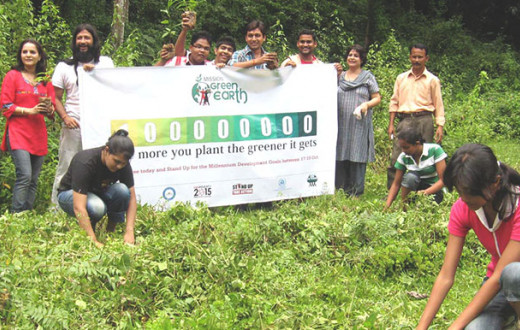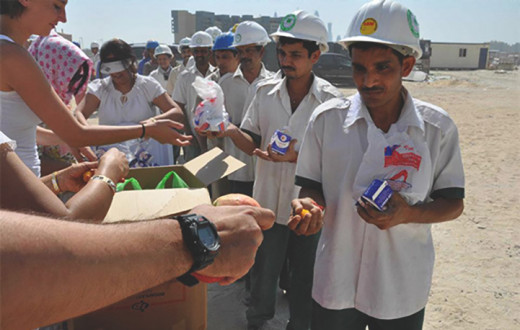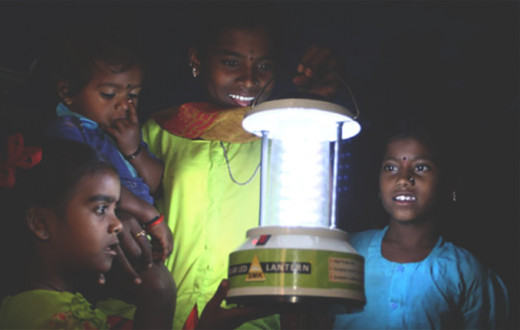The Art of Living is an organisation that has been at the forefront of rejuvenating and cleaning rivers. Over the last few years, our volunteers have been working on reviving 16 rivers across India. Before the Commonwealth Games over 5000 volunteers worked everyday for 6 weeks, as part of the ‘Meri Dilli Meri Yamuna’ initiative, removing 512 tons of garbage from the Yamuna. To now say we are damaging the Yamuna Flood Plains by hosting the World Culture Festival there, is ridiculous. The Art of Living was officially granted permission by the Delhi Development Authority to host the World Culture Festival on the Yamuna Flood plains. If permission had not been granted the event would have been held else where.
Now, over the years the flood plains have been used as an illegal dumping ground of construction debris, ‘Malba’. The images below show large amounts of Malba strewn all across the area. To prepare the grounds for the event The Art of Living cleaned up all the Malba from the area. Some wild grass and weeds were removed but not a single tree was cut. The stage and all other structures are temporary and will be dismantled and removed after the event, returning the area to it’s original, but debris free, state. The flood plain grounds were level to begin with, which is attested by the fact that farming, which requires level land, was being done in the area. With permission from the Environmental Ministry, the grounds were levelled just enough to allow for people to sit and walk.

With 17 drains dumping toxic waste in the Yamuna and creating a thick stench, it would be hard for anyone to stand next to the river for 3 minutes, let alone host a 3 day cultural event. With Heads of States from multiple countries, including the President and Prime Minister of our country, present and attendees from 155 countries, The Art of Living wanted to take this as an opportunity to bring the awareness of the international and national community to the importance of conserving our rivers and keeping the Yamuna clean. Months before the event, over a hundred thousand households began preparing enzymes to rid the river of its toxicity and foul smell. The enzyme is made from raw kitchen waste like fruit and vegetable peels and takes three months to get ready. It is completely natural and organic in its cleansing action.

The Art of Living took it as a challenge to go into a very inhospitable and borderline uninhabitable area to conduct an event of this magnitude and to transform to make it cleaner, greener and healthier. Even the buffaloes have begun to recognise the change!
Impact of enzyme on the Yamuna
- Over a 100,000 of our volunteer households in Delhi have prepared the eco-enzyme to clean the Yamuna. It is completely natural and is prepared from organic kitchen waste like fruit and vegetable peels. It takes three months to prepare it for use.
- The condition of the Yamuna a few weeks ago was that there was unbearable stench all over the area. A few days after we started using the enzyme in the Barapullah drain, locals reported that they are able to sleep much better because the stench has significantly reduced.
- They have also pointed out that they have never seen cattle venture into the Yamuna. But over the last few days, they are surprised to see buffaloes and birds in the water. This shows that the toxicity has reduced to a great extent due to the enzyme.
- We have also taken samples of water from the Yamuna before and after a few days of enzyme treatment. There is a marked difference in the quality of water.

- Without any other change in the farming methodology, just spraying the enzyme increased crop yield by a minimum of 10%.
- The quality of the grains produced improved after using the enzyme. The grains were more uniform and healthier. The crops also looked greener and well-developed. The dried up wheat plants turned from yellow to green within 10 days.
- The increase in the quality of the paddy yield fetched a higher selling price. Lab analysis showed that wheat crop sprayed with the enzyme contained a higher percentage of moisture, protein, starch and gluten as compared to the regular wheat crop. With the use of enzymes the SAME crop of cattle feed resulted in 4 rounds of harvest, which is unheard of, as usually 1 crop yields only one round of harvest.
- Potato yield usually has all sizes: small, medium and large. After spraying the enzyme, small sized potatoes disappeared from the yield and all potatoes were of a larger and more uniform size. Green potatoes, which do not cook, disappeared completely from the yield. 10 quintals of extra output per acre was observed.
Other observations related to the enzyme
- Marked improvement in the water quality of a polluted water body in Malaysia in just four days.
- Keeping a jar of the enzyme next to appliances that emit radiation, reduced measured radiation in the surrounding area by more than a fourth.
- A dishwasher with several wounds on the hands found their wounds healing within a couple of days after using the enzyme to wash dishes.
- Usage of the enzyme transformed an unfertilised piece of land into a prosperous healthy farm. Usage of enzyme also improved water retention in water bodies and revived the surrounding eco system.
Other environmental service initiatives by The Art of Living
- We did a massive campaign in 2010 – Meri Dilli, Meri Yamuna, in which our volunteers fished out 512 tons of waste from the river, aside from spreading awareness throughout Delhi.
- Our people are working on reviving 16 rivers that have been dry for several years across the country:

- In 2014, Lok Adalat, High Court of Karnataka recognised the good work done by The Art of Living for river rejuvenation and instructed all the District Administrations of the state to replicate the project to rejuvenate water bodies.
- Art of Living volunteers removed 600 ton’s of garbage that was accumulated in the river Pampa in Kerala because of pilgrims leaving their clothes after taking a dip. The pilgrims were further sensitised to keep the river clean through direct interaction.
- We planted millions of trees all over the world as part of the United Nations ‘Stand Up and Take Action’ initiative.
- This is apart from several environmental service initiatives at the regional level across the world.







